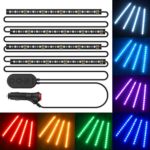Light emitting diodes, commonly known as LEDs, are the most exciting and latest technological advancement in the lighting industry.
LED lights and bulbs are presently being used in a wide variety of applications like; architectural lighting, residential lighting, automotive, aerospace, aviation, electronic instrumentation, industrial automation and controls, broadcasting, gaming and entertainment, the military, safety & transportation and traffic.
There are a number of reasons why you should consider using LED lights and Bulbs in your home or/and business. Below, we`ll highlight seven benefits you and your family should expect from using this amazing technology.
The Benefits of Using LED Lights and Bulbs
1. Reliability and Robustness
The filament bulbs that are used in cars and motorcycles are delicate –their globes are made of fragile glass and can be broken easily. The glowing filaments inside the filament bulb are also quite fragile, made from coils of fine wire.
As a result, they blow often when the filament breaks, particularly when they`re subjected to vibrations bangs, knocks and bumps when driving. It can be rather annoying having to change a bulb at the side of the road and quite dangerous if you find yourself without a spare bulb riding at night – especially if you are in need of a motorcycle headlight.
Thankfully LED bulbs are more robust as they have no delicate glass globe to break or fragile filament inside. Each LED is enclosed in its own plastic block, sealed away from the elements and practically indestructible in normal daily use.
Additionally, because LED bulbs are often made up of arrays of individual LEDs, in the unlikely event that one LED fails there are several others that will continue to function.
2. Many Options
LED bulbs come in smaller sizes than the older bulb types, this gives you more control and flexibility in designing your lighting systems. For example, if you are into indoor gardening and you don’t have enough space in your indoor garden you can place the smaller LED bulbs in more specific positions around the plants.
Additionally, LED`s generate very little heat energy hence they are used optimize space in indoor gardens, due to the fact that they`ll not have any adverse effects such as less yield and leaf burn, on the plants.
3. Long Lifetime
LED bulbs have a maximum lifespan of 60000 hrs. compared to 1500 hrs. for the incandescent bulbs. An LED bulb will last more than seven years (constant use) before requiring replacement. On average, LEDs last ten times as long as CFLs (compact fluorescent lamps), and 133-times longer than the typical incandescent bulbs.
The long lifespan of LED bulbs significantly lower long term operating costs and reduce maintenance costs compared to the traditional fluorescent tubes and incandescent bulbs.
LED lifespan scenarios:
•50000 hrs. powered 4 hours per day =34 year lifespan
•50000 hrs. powered 8 hours per day =17 year lifespan
•50000 hrs. powered 24 hours per day =6 year lifespan
4. Can Operate In Extreme Temperatures
LED bulbs are designed to withstand extreme temperatures. They are the perfect choice for lighting in hot weather because they will not generate unwanted heat and will not become so overheated that they burst.
On the flip side, they`re also quite popular in cold weather due to the fact that they`re able to withstand frigid outdoor temperatures, making them ideal for parking garages, flashlights, business fronts, and outdoor gardens. Additionally, because LED bulbs do not contain any glass components, they`re more able to withstand sudden changes in temperature.
5. The Healthier Choice
Feel great about making a responsible choice. LEDs aren`t harmful to human beings. They don`t contain mercury unlike the closest alternative in terms of efficiency and performance, CFLs (compact fluorescent lamp), which do contain mercury and may leach deadly chemical compounds into the water supply and air as well as contaminate the landfills.
Exposure to mercury can affect the spinal cord, liver, kidney, and brain function leading to difficulty in moving, memory loss, and other symptoms. LEDs also don`t emit IR or UV light, both of which can have negative health effects on our skin.
6. Incentives
Many electricity providers and governments offer incentive and rebate programs to industrial and commercial businesses to encourage them to upgrade their inefficient lighting systems to LED.
7. Cost Savings
LED bulbs offer a lot of benefits, but arguably the greatest benefit, when it comes to commercial and industrial settings is their cost savings. LED bulbs are energy efficient and consume up to 90 percent less power than the incandescent bulbs.
Since LED bulbs use only a small fraction of the energy used by incandescent light bulbs there`s a drastic decrease in power costs. Additionally, energy and money is saved in replacement and maintenance costs because of the long LED lifespan.
In spite of the fact that LEDs have a higher initial cost than the compact fluorescent light bulbs and incandescent bulbs, the cost is quickly recouped over time in lower costs of electricity. Take a single 60W LED bulb, for instance.
Assuming that the LED bulb costs $ 35 and that the cost of electricity is $ 0.10 kWh, the total operating cost for the LED bulb for 50000 hours would be around $ 85. Based on the same electrical costs, it would cost more than $ 350 to run an incandescent bulb for 50,000 hours.
The more lights you are running, the more your savings add up. Industrial plant managers and business owners are always searching for ways to reduce costs and add money to their bottom line. LEDs are one of the most effective ways they can accomplish this.





Comments are disabled for this post.